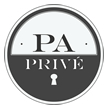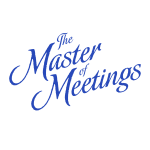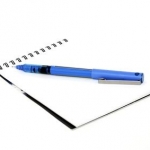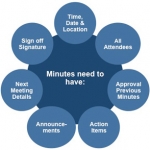
Minutes serve as legal binding documents in many situations and in many organizations and can be produced as evidence of certain discussions and decisions when there are legal challenges in the future. A common job duty of administrative and EAs is to be able to take effective meeting minutes. Whether you are taking minutes at a team meeting or a meeting of the Board of Directors, the skills are pretty much the same.
The following is a guide for making this task easier:
- Choose your tool: Decide how you will take notes, i.e. pen and paper, laptop computer, tape recorder, a steno pad. Many people routinely record important meetings as a backup to their notes.
- Make sure your tool of choice is in working order and have a backup just in case.
- Use the meeting agenda to formulate an outline.
Follow the format of the sample meeting minute template below to help you record meeting minutes.
Example of Minutes Form:
| Name of Organization: Purpose of Meeting: Date / Time: Chair: | |||
| Topic | Discussion | Action | PersonResponsible |
| 1. | |||
| 2. | |||
| 3. | |||
- Include the name of organisation, name of committee, type of meeting (daily, weekly, monthly, annual, or special), and purpose of meeting. (After Meeting)
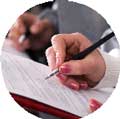
- Always include the time the meeting began and ended as well as those attending.
- Background & purpose of the meeting.
- Names of committee members present. Indicate the chair or co-chairs by using “(ch)” after name.
- Who will be attending? Pass around attendance sheet. Attendance and Apologies. Ask members to indicate their presence, as they arrive, by putting a check mark next to their name.
- To be sure about who said what, make a map of the seating arrangement, and make sure to ask for introductions of unfamiliar people.
- Items discussed as per the agreed agenda.
- Decisions reached.
- Reasons for the decisions being taken.
- Action points, who is to complete them and within what timescales – deadlines.
- It isn’t necessary to take down everything that is said.
- Learn to use Microsoft Word’s Bullets and Numbering functions well. This will be an immense help to you when transcribing minutes.
- When people entered/left the meeting at times other than the beginning or end. It’s a good practice to make note of those who come in late with the time they came in, as well as those leaving early (again with the time). It’ll come up in the future just who was and wasn’t at a particular meeting when a particular discussion occurred. Make sure you always get that down.
- After transcribing your minutes, always send them to your boss for approval before sending them out. She may want to make changes.
- Always file your notes with a hard copy of your minutes, so you can refer back to your notes if there is ever any question of what happened in the meeting.
- The time the meeting was adjourned and the place, time and date of the next meeting.
- A statement listing who was the recording secretary responsible for the minutes. Example: Minutes taken by Helen Anybody.
*What not to include.
- Avoid directly quoting individuals.
- Don’t include unsubstantiated or subjective information or opinions.
What are your tips for taking effective meeting minutes?
